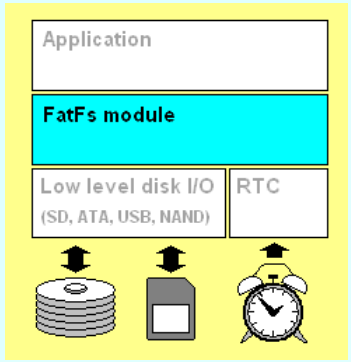FATFS(A)
(一),什么是文件管理系统
答:数据在PC上是以文件的形式储存在磁盘中的,这些数据的形式一般为ASCII码或二进制形式。简单点说就是:管理磁盘上的文件的方法的代码!
如:我们写到SD卡上面的数据管理一下,更科学的方法来管理
http://elm-chan.org/fsw/ff/00index_e.html,官网介绍 Resources下面是源码
(二),我们在移植时主要是那些函数?
答:Device Control Interface(硬件接口函数)
- disk_status - Get device status 选择操纵的模块,此处用SD卡
- disk_initialize - Initialize device 初始化函数
- disk_read - Read sector(s) 读
- disk_write - Write sector(s) 写
- disk_ioctl - Control device dependent features
- get_fattime - Get current time
(三),例程:
1,我们用的是0.09版本的
2,CC936.c中文字体库
①新建工作区间
/* Register work area for each volume (Always succeeds regardless of disk status) */
f_mount(0,&fs); //(文件管理系统)注册一个工作区间,工作空间命名为0。
那么工作区间的命名范围是什么呢?
答:
FRESULT f_mount (
BYTE vol, /* Logical drive number to be mounted/unmounted */
FATFS *fs /* Pointer to new file system object (NULL for unmount)*/
)
{
FATFS *rfs; if (vol >= _VOLUMES) /* Check if the drive number is valid */
return FR_INVALID_DRIVE;
vol就是f_mount的第一个形参(命名),当他的值大于等于 _VOLUMES,就会返回错误
#define _VOLUMES 1 //can define 9
/* Number of volumes (logical drives) to be used. */
Parameters(官网)
- Drive
- Logical drive number (0-9) to register/unregister the work area.
- FileSystemObject
- Pointer to the work area (file system object) to be registered.
②然后再工作区间里面新建文件
/* function disk_initialize() has been called in f_open */ /* Create new file on the drive 0 */
res = f_open(&fnew, "0:newfile.txt", FA_CREATE_ALWAYS | FA_WRITE );
OPEN的属性:
1.怎么打开呢?
FA_CREATE_ALWAYS 总是以创建总是新建的形式打开这个文件
FA_WRITE:此文件只能写
2.看下open函数
FRESULT f_open (
FIL* FileObject, /* Pointer to the blank file object structure */ 文件指针,把打开的文件关联到这个指针连
const TCHAR* FileName, /* Pointer to the file neme */ 文件名字
BYTE ModeFlags /* Mode flags */ 属性
);
属性:
| Value | Description |
|---|---|
| FA_READ | Specifies read access to the object. Data can be read from the file. Combine with FA_WRITE for read-write access. |
| FA_WRITE | Specifies write access to the object. Data can be written to the file. Combine with FA_READ for read-write access. |
| FA_OPEN_EXISTING | Opens the file. The function fails if the file is not existing. (Default) |
| FA_OPEN_ALWAYS | Opens the file if it is existing. If not, a new file is created. To append data to the file, use f_lseek function after file open in this method. |
| FA_CREATE_NEW | Creates a new file. The function fails with FR_EXIST if the file is existing. |
| FA_CREATE_ALWAYS | Creates a new file. If the file is existing, it is truncated and overwritten. |
可以第一次打开用:FA_CREATE_NEW,之后打开用:FA_OPEN_EXISTING(已存在)就可以了
或者:总是打开,总是关闭
当用到:FA_CREATE_ALWAYS时,我们要将 #define _FS_READONLY 0 /* 0:Read/Write or 1:Read only */ 打开
3.对于返回值(Return Values):我们只测试:FR_OK(是否成功)
③往该文件内写数据
if ( res == FR_OK )
{
res = f_write(&fnew, textFileBuffer, sizeof(textFileBuffer), &bw);
f_close(&fnew); 写完之后,把该文件关掉
}
④关掉之后再打开它
res = f_open(&fnew, "0:newfile.txt", FA_OPEN_EXISTING | FA_READ); // FA_READ:此时打开定义可读
⑤读取数据
res = f_read(&fnew, buffer, sizeof(buffer), &br);
⑥打印之后关闭
printf("\r\n %s ", buffer);
/* Close open files */
f_close(&fnew);
⑦在文件系统中注册掉刚才开辟的“0”工作区间
/* Unregister work area prior to discard it */
f_mount(0, NULL);
(四)文件管理系统与SD卡的关联!

1,Application:就是我们主函数中使用的那些上层函数
2,中间是文件系统模块,文件系统要操纵底层SD卡的时候呢还需要 Low level disk I/O,这一部分驱动,这一部分驱动需要我们自己写
/*-------------------------- SD Init ----------------------------- */
Status = SD_Init();
if (Status!=SD_OK )
{
return STA_NOINIT;
}
else
{
return RES_OK;
} }
和
/*-----------------------------------------------------------------------*/
/* Return Disk Status */ DSTATUS disk_status (
BYTE drv /* Physical drive nmuber (0..) */
)
{
return RES_OK;
}
底层的磁盘的读/写
/*-----------------------------------------------------------------------*/
/* Read Sector(s) */ DRESULT disk_read (
BYTE drv, /* Physical drive nmuber (0..) */
BYTE *buff, /* Data buffer to store read data */
DWORD sector, /* Sector address (LBA) */
BYTE count /* Number of sectors to read (1..255) */
)
{ if (count > 1) //多个磁盘
{
SD_ReadMultiBlocks(buff, sector*BLOCK_SIZE, BLOCK_SIZE, count); /* Check if the Transfer is finished */
SD_WaitReadOperation(); //循环查询dma传输是否结束 /* Wait until end of DMA transfer */
while(SD_GetStatus() != SD_TRANSFER_OK);
}
else //单个磁盘
{ SD_ReadBlock(buff, sector*BLOCK_SIZE, BLOCK_SIZE); /* Check if the Transfer is finished */
SD_WaitReadOperation(); //循环查询dma传输是否结束 /* Wait until end of DMA transfer */
while(SD_GetStatus() != SD_TRANSFER_OK); }
return RES_OK;
} /*-----------------------------------------------------------------------*/
/* Write Sector(s) */ #if _READONLY == 0
DRESULT disk_write (
BYTE drv, /* Physical drive nmuber (0..) */
const BYTE *buff, /* Data to be written */
DWORD sector, /* Sector address (LBA) */
BYTE count /* Number of sectors to write (1..255) */
)
{ if (count > 1)
{
SD_WriteMultiBlocks((uint8_t *)buff, sector*BLOCK_SIZE, BLOCK_SIZE, count); /* Check if the Transfer is finished */
SD_WaitWriteOperation(); //等待dma传输结束
while(SD_GetStatus() != SD_TRANSFER_OK); //等待sdio到sd卡传输结束
}
else
{
SD_WriteBlock((uint8_t *)buff,sector*BLOCK_SIZE, BLOCK_SIZE); /* Check if the Transfer is finished */
SD_WaitWriteOperation(); //等待dma传输结束
while(SD_GetStatus() != SD_TRANSFER_OK); //等待sdio到sd卡传输结束
}
return RES_OK;
}
#endif /* _READONLY */
IO控制为空(直接返回OK)
/*-----------------------------------------------------------------------*/
/* Miscellaneous Functions */ DRESULT disk_ioctl (
BYTE drv, /* Physical drive nmuber (0..) */
BYTE ctrl, /* Control code */
void *buff /* Buffer to send/receive control data */
)
{
return RES_OK;
}
嵌入式初学者,看到此文的大神们,有什么错误的地方多多意见啊!
FATFS(A)的更多相关文章
- 【STM32】使用SDIO进行SD卡读写,包含文件管理FatFs(终)-配合内存管理来遍历SD卡
[STM32]使用SDIO进行SD卡读写,包含文件管理FatFs(一)-初步认识SD卡 [STM32]使用SDIO进行SD卡读写,包含文件管理FatFs(二)-了解SD总线,命令的相关介绍 [STM3 ...
- 【STM32】使用SDIO进行SD卡读写,包含文件管理FatFs(八)-认识内存管理
[STM32]使用SDIO进行SD卡读写,包含文件管理FatFs(一)-初步认识SD卡 [STM32]使用SDIO进行SD卡读写,包含文件管理FatFs(二)-了解SD总线,命令的相关介绍 [STM3 ...
- 【STM32】使用SDIO进行SD卡读写,包含文件管理FatFs(七)-准备移植FatFs
[STM32]使用SDIO进行SD卡读写,包含文件管理FatFs(一)-初步认识SD卡 [STM32]使用SDIO进行SD卡读写,包含文件管理FatFs(二)-了解SD总线,命令的相关介绍 [STM3 ...
- 【STM32】使用SDIO进行SD卡读写,包含文件管理FatFs(六)-FatFs使用的思路介绍
[STM32]使用SDIO进行SD卡读写,包含文件管理FatFs(一)-初步认识SD卡 [STM32]使用SDIO进行SD卡读写,包含文件管理FatFs(二)-了解SD总线,命令的相关介绍 [STM3 ...
- 【STM32】使用SDIO进行SD卡读写,包含文件管理FatFs(五)-文件管理初步介绍
其他链接 [STM32]使用SDIO进行SD卡读写,包含文件管理FatFs(一)-初步认识SD卡 [STM32]使用SDIO进行SD卡读写,包含文件管理FatFs(二)-了解SD总线,命令的相关介绍 ...
- 【STM32】使用SDIO进行SD卡读写,包含文件管理FatFs(一)-初步认识SD卡
由于一张SD卡要能读写,涉及到的技术有些多,我打算分以下几篇博客 [STM32]使用SDIO进行SD卡读写,包含文件管理FatFs(一)-初步认识SD卡 [STM32]使用SDIO进行SD卡读写,包含 ...
- 【STM32】使用SDIO进行SD卡读写,包含文件管理FatFs(二)-了解SD总线,命令的相关介绍
其他链接 [STM32]使用SDIO进行SD卡读写,包含文件管理FatFs(一)-初步认识SD卡 [STM32]使用SDIO进行SD卡读写,包含文件管理FatFs(二)-了解SD总线,命令的相关介绍 ...
- 【STM32】使用SDIO进行SD卡读写,包含文件管理FatFs(三)-SD卡的操作流程
其他链接 [STM32]使用SDIO进行SD卡读写,包含文件管理FatFs(一)-初步认识SD卡 [STM32]使用SDIO进行SD卡读写,包含文件管理FatFs(二)-了解SD总线,命令的相关介绍 ...
- 【STM32】使用SDIO进行SD卡读写,包含文件管理FatFs(四)-介绍库函数,获取一些SD卡的信息
其他链接 [STM32]使用SDIO进行SD卡读写,包含文件管理FatFs(一)-初步认识SD卡 [STM32]使用SDIO进行SD卡读写,包含文件管理FatFs(二)-了解SD总线,命令的相关介绍 ...
随机推荐
- win7操作系统说明
· 能够使用windows7操作系统成为了许多电脑用户的一大喜悦之事,相比之前的Vista系统,windows7系统真的是好看了,快了,好用了,但你是否担心自己的windows7系统就像新安装其他Wi ...
- uboot 下更改NAND的分区 fdisk
uboot 下更改NAND的分区 fdisk 分类: S5PXX(三星)2012-07-01 18:59 8946人阅读 评论(7) 收藏 举报 flash平台cacheandroid三星null 关 ...
- HashMap 的工作原理及代码实现,什么时候用到红黑树
HashMap工作原理及什么时候用到的红黑树: 在jdk 1.7中,HashMap采用位桶+链表实现,即使用链表处理冲突,同一hash值的链表都存储在一个链表里.但是当位于一个桶中的元素较多,即has ...
- python xlwt 设置单元格样式-合并单元格
xlwt模块详解--合并单元格 import xlwtworkbook = xlwt.Workbook()worksheet = workbook.add_sheet('My sheet')# 合并第 ...
- 10 jmeter之动态关联
jmeter中关联是通过之前请求的后置处理器实现的,具体有两种方式:XPath Extractor(一般xml的时候用的多)和正则表达式提取器. 以webtours登录为例进行演示login.jmx ...
- ABP项目创建
第一种:1.在MyAbp.Migrator下面的appsettings.json里面的sql连接语句 MyAbp.Web.Host 下面的appsettings.json 里面的连接语句2.把MyAb ...
- [vue]vue条件渲染v-if(template)和自定义指令directives
条件渲染: v-if/template <div id="app"> <h1>v-show: display: none</h1> <di ...
- INT_MAX和INT_MIN注意事项
版权声明:转载请注明出处 http://blog.csdn.net/TwT520Ly https://blog.csdn.net/TwT520Ly/article/details/53038345 I ...
- 让你分分钟了解Web接口测试
因为前后端架构分离技术的兴起,接口测试也越来越重要,最近一直想总结下,作为一个近三年的测试人员,接口这个词是耳濡目染的,而开发张口闭口也都是这个接口或那个接口怎么怎么样,自己遇到的bug也很多是接口问 ...
- ios 工作日志
1.设计模式 1.1 想用一个controllerK控制多个页面的切换 但是每一个页面必须要引用这个controller,这样才能控制进度, 所以必须是弱引用.controller必须被某一个实例强引 ...
